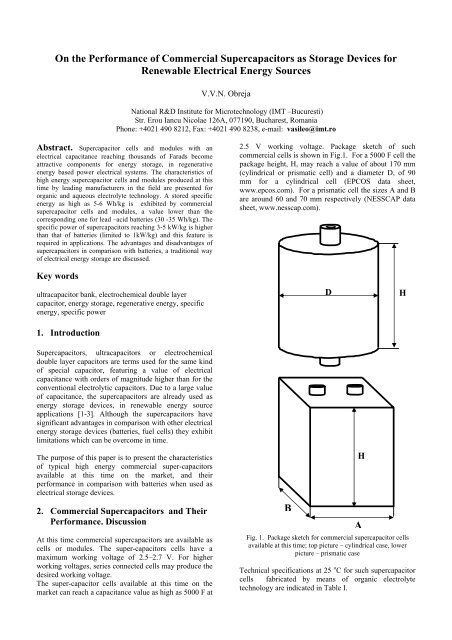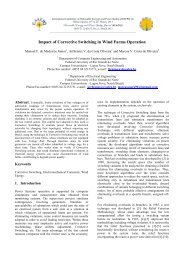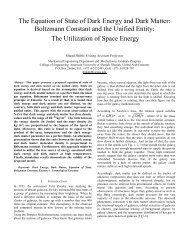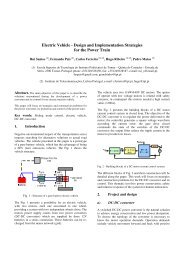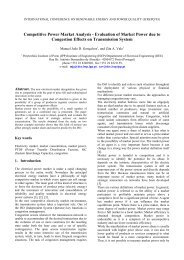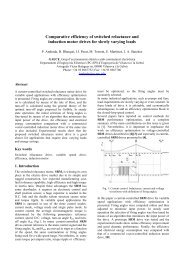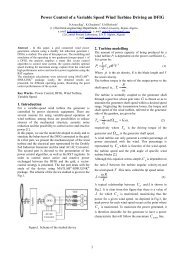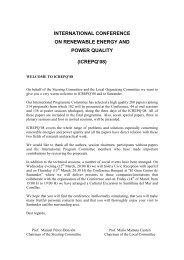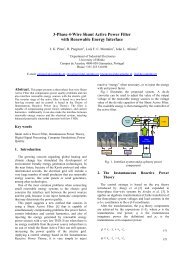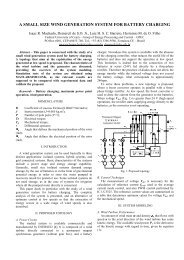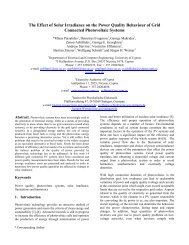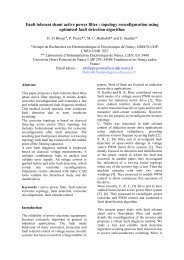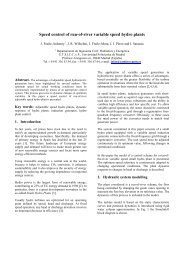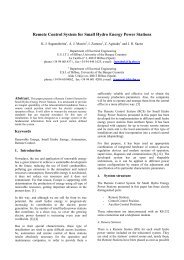On the Performance of Commercial Supercapacitors - Icrepq.com
On the Performance of Commercial Supercapacitors - Icrepq.com
On the Performance of Commercial Supercapacitors - Icrepq.com
Create successful ePaper yourself
Turn your PDF publications into a flip-book with our unique Google optimized e-Paper software.
<strong>On</strong> <strong>the</strong> <strong>Performance</strong> <strong>of</strong> <strong>Commercial</strong> <strong>Supercapacitors</strong> as Storage Devices for<br />
Renewable Electrical Energy Sources<br />
V.V.N. Obreja<br />
National R&D Institute for Microtechnology (IMT –Bucuresti)<br />
Str. Erou Iancu Nicolae 126A, 077190, Bucharest, Romania<br />
Phone: +4021 490 8212, Fax: +4021 490 8238, e-mail: vasileo@imt.ro<br />
Abstract. Supercapacitor cells and modules with an<br />
electrical capacitance reaching thousands <strong>of</strong> Farads be<strong>com</strong>e<br />
attractive <strong>com</strong>ponents for energy storage, in regenerative<br />
energy based power electrical systems. The characteristics <strong>of</strong><br />
high energy supercapacitor cells and modules produced at this<br />
time by leading manufacturers in <strong>the</strong> field are presented for<br />
organic and aqueous electrolyte technology. A stored specific<br />
energy as high as 5-6 Wh/kg is exhibited by <strong>com</strong>mercial<br />
supercapacitor cells and modules, a value lower than <strong>the</strong><br />
corresponding one for lead –acid batteries (30 -35 Wh/kg). The<br />
specific power <strong>of</strong> supercapacitors reaching 3-5 kW/kg is higher<br />
than that <strong>of</strong> batteries (limited to 1kW/kg) and this feature is<br />
required in applications. The advantages and disadvantages <strong>of</strong><br />
supercapacitors in <strong>com</strong>parison with batteries, a traditional way<br />
<strong>of</strong> electrical energy storage are discussed.<br />
2.5 V working voltage. Package sketch <strong>of</strong> such<br />
<strong>com</strong>mercial cells is shown in Fig.1. For a 5000 F cell <strong>the</strong><br />
package height, H, may reach a value <strong>of</strong> about 170 mm<br />
(cylindrical or prismatic cell) and a diameter D, <strong>of</strong> 90<br />
mm for a cylindrical cell (EPCOS data sheet,<br />
www.epcos.<strong>com</strong>). For a prismatic cell <strong>the</strong> sizes A and B<br />
are around 60 and 70 mm respectively (NESSCAP data<br />
sheet, www.nesscap.<strong>com</strong>).<br />
Key words<br />
ultracapacitor bank, electrochemical double layer<br />
capacitor, energy storage, regenerative energy, specific<br />
energy, specific power<br />
1. Introduction<br />
<strong>Supercapacitors</strong>, ultracapacitors or electrochemical<br />
double layer capacitors are terms used for <strong>the</strong> same kind<br />
<strong>of</strong> special capacitor, featuring a value <strong>of</strong> electrical<br />
capacitance with orders <strong>of</strong> magnitude higher than for <strong>the</strong><br />
conventional electrolytic capacitors. Due to a large value<br />
<strong>of</strong> capacitance, <strong>the</strong> supercapacitors are already used as<br />
energy storage devices, in renewable energy source<br />
applications [1-3]. Although <strong>the</strong> supercapacitors have<br />
significant advantages in <strong>com</strong>parison with o<strong>the</strong>r electrical<br />
energy storage devices (batteries, fuel cells) <strong>the</strong>y exhibit<br />
limitations which can be over<strong>com</strong>e in time.<br />
D<br />
H<br />
The purpose <strong>of</strong> this paper is to present <strong>the</strong> characteristics<br />
<strong>of</strong> typical high energy <strong>com</strong>mercial super-capacitors<br />
available at this time on <strong>the</strong> market, and <strong>the</strong>ir<br />
performance in <strong>com</strong>parison with batteries when used as<br />
electrical storage devices.<br />
2. <strong>Commercial</strong> <strong>Supercapacitors</strong> and Their<br />
<strong>Performance</strong>. Discussion<br />
At this time <strong>com</strong>mercial supercapacitors are available as<br />
cells or modules. The super-capacitors cells have a<br />
maximum working voltage <strong>of</strong> 2.5–2.7 V. For higher<br />
working voltages, series connected cells may produce <strong>the</strong><br />
desired working voltage.<br />
The super-capacitor cells available at this time on <strong>the</strong><br />
market can reach a capacitance value as high as 5000 F at<br />
B<br />
Fig. 1. Package sketch for <strong>com</strong>mercial supercapacitor cells<br />
available at this time; top picture – cylindrical case, lower<br />
picture – prismatic case<br />
Technical specifications at 25 o C for such supercapacitor<br />
cells fabricated by means <strong>of</strong> organic electrolyte<br />
technology are indicated in Table I.<br />
H<br />
A
TABLE I – Characteristics <strong>of</strong> large supercapacitor cells<br />
(organic electrolyte technology)<br />
Technical Specifications<br />
Rated capacitance (Farads),<br />
tollerance %)<br />
NESSCAP<br />
Cell Type<br />
ESHSP-<br />
5000C0-<br />
002R7<br />
5 000<br />
-10%,<br />
+20 %<br />
EPCOS<br />
Cell Type<br />
B49410B-<br />
2506Q000<br />
5 000<br />
-10%, +30<br />
%<br />
Rated voltage, V R (Volts) 2.7 2.5<br />
Maximum internal 0.35 (0.4) (0.2) 0.35<br />
resistance ( mohms)<br />
Maximum leakage current 22 No spec.<br />
(mAmps)<br />
Surge voltage (Volts) 2.85 2.8<br />
Maximum stored energy at<br />
rated voltage (Joule )<br />
18225<br />
(5.06 Wh)<br />
15625<br />
(4.34 Wh)<br />
Specific energy (Wh/kg ; 5.69 ; 7.10 4.1 ; 4.7<br />
Wh/l) at V= V R<br />
Specific power ( kW/kg ; 5.12; 6.39* 2 ; 2.3**<br />
kW/l)<br />
Weight (grams) 890 1050<br />
Volume (mlitres) 713 930<br />
Operating temperature range -40…+ 60 -30…+70<br />
( o C)<br />
Cycle life (cycles ) 500 000 500 000<br />
* The cell load is equal with its internal resistance<br />
**The cell load is higher than its internal resistance<br />
It is seen from Table I that different parameter values are<br />
possible for organic electrolyte supercapacitor cells <strong>of</strong> <strong>the</strong><br />
same capacitance value but belonging to different<br />
manufacturers. Higher maximum working (rated) voltage<br />
results in higher stored energy. The weight and <strong>the</strong><br />
volume <strong>of</strong> <strong>the</strong> two cells is not <strong>the</strong> same. As a<br />
consequence <strong>the</strong> specific energy and power has different<br />
values.<br />
If aqueous electrolyte technology is used <strong>the</strong>n <strong>the</strong> cell<br />
rated voltage is lower than 2 V. A <strong>com</strong>parison between<br />
an organic electrolyte 3000 F cell (Maxwell<br />
Technologies, www.maxwell.<strong>com</strong>) and an aqueous<br />
electrolyte 3200 F cell (ESMA, www.esma-cap.<strong>com</strong>) is<br />
given in <strong>the</strong> Table II. <strong>On</strong>e can see from Table II that<br />
lower rated voltage <strong>of</strong> 1.5 V for aqueous electrolyte cell<br />
results in significant lower stored energy in <strong>com</strong>parison<br />
with <strong>the</strong> organic electrolyte cell <strong>of</strong> 2.7 V. None<strong>the</strong>less<br />
for <strong>the</strong> EC104 cell, lower weight and volume is<br />
manifested. At lower weight or volume than that used for<br />
organic electrolyte cells with characteristics given in<br />
Table I, significantly higher capacitance values can be<br />
achieved if aqueous electrolyte is used. Typical results<br />
are shown in Table III for supercapacitor cells fabricated<br />
by <strong>the</strong> ESMA manufacturer. These cells are not available<br />
as <strong>com</strong>mercial products but <strong>the</strong>y are used in <strong>com</strong>mercial<br />
modules produced by <strong>the</strong> same <strong>com</strong>pany. At this time,<br />
organic electrolyte based cells <strong>of</strong> capacitance value<br />
higher than 5000 F are not available as <strong>com</strong>mercial<br />
products and nei<strong>the</strong>r such cells are used in <strong>com</strong>mercial<br />
modules. For aqueous electrolyte cells, huge capacitance<br />
values are possible if higher weight and volume is used.<br />
TABLE II- Comparison <strong>of</strong> characteristics for supercapacitor<br />
cells with organic and aqueous electrolyte technology<br />
Technical Specifications<br />
MAXWELL<br />
TECHNO-<br />
LOGIES<br />
Cell Type<br />
BCAP-<br />
3000P270<br />
ESMA<br />
Cell Type<br />
(aqueuos<br />
electrolyte)<br />
EC104<br />
Rated capacitance (Farads) 3 000 3 200<br />
Rated voltage, V R (Volts) 2.7 1.5<br />
Maximum internal 0.24 (0.29) 0.6 (0.9)<br />
resistance ( mohms)<br />
Maximum leakage current 5.2 5<br />
(mAmps)<br />
Surge voltage (Volts) No spec. 1.6<br />
Maximum stored energy at<br />
rated voltage (Joule )<br />
10935<br />
(3.04 Wh)<br />
3600<br />
(1 Wh)<br />
Specific energy (Wh/kg ; 5.52 ; 6.4 2.94; 5.12<br />
Wh/l) at V= V R<br />
Specific power (kW/kg ; 5.12; 6.39* 2.64; 4.61*<br />
kW/l)<br />
Weight (grams) 550 340<br />
Volume (mlitres) 475 195<br />
Operating temperature range -40…+ 65 -50…+50<br />
( o C)<br />
Cycle life (cycles ) 1 000 000 >300 000<br />
* The supercapacitor load is equal with its internal resistance<br />
TABLE III- Aqueous electrolyte cells <strong>of</strong> higher capacitance<br />
values than organic electrolyte cells (Table I)<br />
Technical Specifications<br />
ESMA<br />
Cell Type<br />
EC501<br />
ESMA<br />
Cell Type<br />
EC404<br />
Rated Capacitance (Farads) 6 000 14 000<br />
Rated Voltage, V R (Volts) 1.5 1.6<br />
Maximum internal 0.3(0.5) 0.4 (0.6)<br />
resistance ( mohms)<br />
Maximum Leakage current 10 10<br />
(mAmps)<br />
Surge Voltage (Volts) 1.6 1.75<br />
Maximum stored energy at<br />
rated voltage (Joule )<br />
6750<br />
(1.87Wh)<br />
17920<br />
(4.98 Wh)<br />
Specific energy ( Wh/kg ; 2.67 ; 4.80 5.53 ; 9.05<br />
Wh/l) at V= V R<br />
Specific power ( kW/kg ; 2.57; 4.80* 2 ; 3.27*<br />
kW/l)<br />
Weight (grams) 700 900<br />
Volume (mlitres) 389 550<br />
Operating temperature range -50…+ 50 -50…+50<br />
( o C)<br />
Cycle life (cycles ) >300000 100000<br />
* The supercapacitor load is equal with its internal resistance<br />
Specifications <strong>of</strong> such cells manufactured by ESMA are<br />
given in Table IV. From Table IV one can see that higher<br />
specific energy is exhibited in <strong>com</strong>parison with <strong>the</strong><br />
organic electrolyte based cells (Table I). Suitable<br />
manufacturing process can provide lower weight<br />
/volume.
TABLE IV- Aqueous electrolyte cells <strong>of</strong> very high capacitance<br />
value<br />
Technical Specifications<br />
ESMA<br />
Cell Type<br />
EC303<br />
ESMA<br />
Cell Type<br />
EC 353<br />
Rated capacitance (Farads) 45 000 80 000<br />
Rated voltage, V R (Volts) 1.6 1.7<br />
Maximum internal 0.2(0.3) 0.5 (1.0)<br />
resistance ( mohms)<br />
Maximum leakage current 30 No spec.<br />
(mAmps)<br />
Surge voltage (Volts) 1.75 1.75<br />
Maximum stored energy at<br />
rated voltage (Joule )<br />
57600<br />
(16Wh)<br />
115600<br />
(32Wh)<br />
Specific energy (Wh/kg ;<br />
Wh/l) at V= V R<br />
6.15 ; 9.51 13.33;<br />
19.02<br />
Specific power ( kW/kg ; 1.23; 1.90* 0.58;0.8*<br />
kW/l)<br />
Weight (grams) 2600 2400<br />
Volume (mlitres) 1682 1682<br />
Operating temperature range -50…+ 50 -50…+50<br />
( o C)<br />
Cycle life (cycles ) 100000 >10000<br />
* The supercapacitor load is equal with its internal resistance<br />
None<strong>the</strong>less <strong>the</strong> specific power remains significantly<br />
lower in <strong>com</strong>parison with <strong>the</strong> corresponding one for<br />
organic electrolyte based cells. The aqueous electrolyte<br />
technology, [4], enables significantly higher capacitance<br />
values in <strong>com</strong>parison with <strong>the</strong> organic electrolyte<br />
technology.<br />
For power electrical systems using regenerative energy<br />
sources, higher working voltage than 3-5 V is required<br />
for supercapacitors to be used as energy storage<br />
<strong>com</strong>ponents. Consequently, serial connection <strong>of</strong> cells in<br />
modules is performed with suitable cell voltage balance,<br />
[5], so that <strong>the</strong> cell voltage during operation to be kept<br />
below <strong>the</strong> specified rated value. Characteristics <strong>of</strong> high<br />
energy modules based on organic electrolyte cells (Table<br />
I) are shown in Table V. <strong>On</strong>e can see that significant<br />
decrease <strong>of</strong> <strong>the</strong> specific energy and power takes place<br />
when <strong>the</strong> cells are connected in series into a module<br />
(Table I). In <strong>the</strong> data sheets <strong>of</strong> EPCOS or NESSCAP<br />
<strong>com</strong>panies, lower rated voltage ( 15 V, 28 V) modules<br />
can be seen but <strong>the</strong> modules from Table V are <strong>of</strong> high<br />
energy storage capability and still with potential use in<br />
renewable energy or power quality applications. A<br />
<strong>com</strong>parison <strong>of</strong> modules with organic electrolyte cells and<br />
aqueous electrolyte cells <strong>of</strong> about <strong>the</strong> same energy storing<br />
capability is shown in Table VI. Higher number <strong>of</strong><br />
aqueous electrolyte cells used for series connection<br />
results in lower specific stored energy. Never<strong>the</strong>less if<br />
aqueous electrolyte cells <strong>of</strong> 45000 F or 80000 F are used,<br />
<strong>the</strong>n higher specific stored energy is obtained in<br />
<strong>com</strong>parison with <strong>the</strong> modules based on organic<br />
electrolyte cells (Table V). Characteristics <strong>of</strong> such<br />
<strong>com</strong>mercial modules <strong>of</strong> very high storing energy<br />
capability are given in Table VII. None<strong>the</strong>less <strong>the</strong> power<br />
capability remains low.<br />
TABLE V- High energy <strong>com</strong>mercial supercapacitor modules<br />
based on organic electrolyte cells.<br />
Technical Specifications<br />
NESSCAP<br />
Module<br />
Type<br />
EMHSP-<br />
5000C0-<br />
002R7<br />
Rated capacitance (Farads) 238<br />
(21 cells <strong>of</strong><br />
5000 F /<br />
2.7V in<br />
series)<br />
Rated voltage, V R (Volts) 52.5<br />
(56.7max.)<br />
Maximum internal<br />
resistance ( mohms)<br />
Maximum leakage current<br />
(mAmps)<br />
EPCOS<br />
Module<br />
Type<br />
7(8.5) 4 (8)<br />
B48621A-<br />
9215Q024<br />
210<br />
24 cells <strong>of</strong><br />
5000 F /<br />
2.5V in<br />
series<br />
56<br />
110 No spec.<br />
Surge voltage (Volts) 59.8 64<br />
Maximum stored energy at<br />
rated voltage (Joule )<br />
382600<br />
(106 Wh)<br />
329280<br />
(91.5 Wh)<br />
Specific energy (Wh/kg ; 3.3 ; 2.8 3 ; 2.1<br />
Wh/l) at V= V R<br />
Specific power ( kW/kg ; 3.0 ; 2.5* 1.6; 1.1**<br />
kW/l)<br />
Weight (kg) 32 30<br />
Volume (litres) 38.2 44<br />
Operating temperature range -40…+ 60 -30…+70<br />
( o C)<br />
Cycle life (cycles ) 500000 500000<br />
* The module load is equal with its internal resistance<br />
**The module load is higher than its internal resistance<br />
The performance <strong>of</strong> super-capacitors as energy<br />
accumulators is seldom <strong>com</strong>pared with that <strong>of</strong> batteries.<br />
The lead acid batteries are usually used as energy storage<br />
device in solar energy or wind turbine systems. The<br />
batteries can accumulate significantly higher electrical<br />
energy than super-capacitors. As an example, a 12 V and<br />
60 Ah valve regulated lead acid battery <strong>of</strong> medium size,<br />
having <strong>the</strong> dimensions <strong>of</strong> 261, 136, 230 in mm and a<br />
weight <strong>of</strong> 19 kg can store about 665 Wh energy at full<br />
charging. After this energy is released by discharging, a<br />
battery voltage decrease to about 10 V takes place.<br />
Fur<strong>the</strong>r discharging <strong>of</strong> <strong>the</strong> battery at lower voltage than<br />
10 V cannot take place without its failure. The stored<br />
specific energy is 35 Wh/kg or about 80 Wh/l, figures<br />
that characterize <strong>the</strong> lead acid batteries. The maximum<br />
stored energy <strong>of</strong> this battery <strong>of</strong> 665 Wh is <strong>com</strong>parable<br />
with <strong>the</strong> corresponding figure for <strong>the</strong> 30EC353U module<br />
in Table VII. This supercapacitor module is equivalent as<br />
energy storage capability with three paralleled modules<br />
<strong>of</strong> 16 V (<strong>the</strong> 10 E353 U module type according to ESMA<br />
datasheets). A 10EC353U module contains only ten<br />
supercapacitor cells <strong>of</strong> <strong>the</strong> same type ( EC 353 cell in<br />
Table IV) connected in series. Three 10EC353U modules<br />
connected in parallel have practical <strong>the</strong> same energy<br />
storage capability <strong>of</strong> about 848 Wh as in Table VII. The<br />
discharge <strong>of</strong> such three paralleled modules from 16 V to<br />
half <strong>of</strong> this value results in about ¾ use <strong>of</strong> <strong>the</strong> initial<br />
stored energy, that is, 636Wh. This value, practically,<br />
corresponds to <strong>the</strong> total available stored energy <strong>of</strong> <strong>the</strong><br />
above battery. As a consequence <strong>of</strong> <strong>the</strong> above, by suitable
TABLE VI- Comparison <strong>of</strong> modules performance with organic<br />
and aqueous electrolyte cells.<br />
MAXWELL<br />
TECHNO-<br />
Technical Specifications LOGIES<br />
Module<br />
Type<br />
BMOD-<br />
0165P048<br />
Rated capacitance (Farads) 165<br />
(18 cells <strong>of</strong><br />
3000F /<br />
2.7V in<br />
series)<br />
ESMA<br />
Module<br />
Type<br />
30EC501U<br />
200<br />
(30 cells <strong>of</strong><br />
6000F/ 1.5<br />
V in series)<br />
Rated voltage, V R (Volts) 48 45<br />
Maximum internal 5.2 (6.1) 9 (14)<br />
resistance ( mohms)<br />
Maximum leakage current 5.2 10<br />
(mAmps)<br />
Surge voltage (Volts) No spec. 48<br />
Maximum stored energy at<br />
rated voltage (Joule )<br />
196830<br />
(54.7 Wh)<br />
202500<br />
(56.2 Wh)<br />
Specific energy ( Wh/kg ; 3.81 ; 7.9 2.08; 2.85<br />
Wh/l) at V= V R<br />
Specific power ( kW/kg ; 7.8; 8.7* 2.07; 2.85*<br />
kW/l)<br />
Weight (kg) 14.2 27<br />
Volume (litres) 12.6 19.7<br />
Operating temperature range -40…+ 65 -50…+50<br />
( o C)<br />
Cycle life (cycles ) 1 000 000 300 000<br />
* The module load is equal with its internal resistance<br />
connection (paralleling or in series) <strong>of</strong> <strong>com</strong>mercial<br />
supercapacitor modules available at this time, energy<br />
storage capability <strong>com</strong>parable with that <strong>of</strong> a lead-acid<br />
battery can be reached. None<strong>the</strong>less a disadvantage <strong>of</strong><br />
this energy storage solution instead <strong>of</strong> batteries is a<br />
significant higher weight and volume. For stationary<br />
power systems <strong>of</strong> renewable energy, this may be not a<br />
major disadvantage. A major disadvantage could be <strong>the</strong><br />
high cost <strong>of</strong> a supercapacitor storage unit in <strong>com</strong>parison<br />
with a lead-acid battery. At this time a target price for<br />
large supercapacitor cells is 1 cent/Farad. Never<strong>the</strong>less<br />
use <strong>of</strong> supercapacitors as energy storage <strong>com</strong>ponents in<br />
power systems has advantages like higher cycle life. A<br />
lead acid battery has to be replaced after 500 - 800<br />
cycles. This number <strong>of</strong> cycles is valid for 25 o C, but for<br />
higher temperature operation, lower number has to be<br />
considered. From <strong>the</strong> above tables one can see that<br />
supercapacitors can operate long time at 50 - 65 o C,<br />
performance which is not possible for batteries. Good<br />
performance is also manifested by supercapacitors at<br />
negative temperature <strong>of</strong> -30 … - 40 o C whereas for<br />
batteries such temperature is not re<strong>com</strong>mended.. Also,<br />
supercapacitors can deliver for short time electrical<br />
energy at significantly higher power than batteries. This<br />
advantage and charging / discharging in a short time<br />
makes possible usage <strong>of</strong> hybrid supercapacitor–battery<br />
units in applications including renewable energy power<br />
systems, [6-7]. O<strong>the</strong>r advantages <strong>of</strong> supercapacitors in<br />
<strong>com</strong>parison with batteries are related to maintenance and<br />
impact on environment. <strong>Supercapacitors</strong> are maintenance<br />
free and use materials with less influence on <strong>the</strong><br />
environment.<br />
TABLE VII- Comercial modules with aqueous electrolyte<br />
cells <strong>of</strong> very high storage energy capability<br />
Technical Specifications<br />
ESMA<br />
Module<br />
Type<br />
30EC303U<br />
Rated capacitance (Farads) 1500<br />
(30 cells <strong>of</strong><br />
45kF/1.5V<br />
in series)<br />
ESMA<br />
Module<br />
Type<br />
30EC353U<br />
2650<br />
(30 cells <strong>of</strong><br />
80 kF/1.6<br />
V in series<br />
Rated voltage, V R (Volts) 45 48<br />
Maximum internal 6(9) 15 (30)<br />
resistance ( mohms)<br />
Maximum leakage current No spec. No spec.<br />
(mAmps)<br />
Surge voltage (Volts) 52 52<br />
Maximum stored energy at<br />
rated voltage (Joule )<br />
1518750<br />
(422 Wh)<br />
3052800<br />
(848 Wh)<br />
Specific energy (Wh/kg ;<br />
Wh/l) at V= V R<br />
6.15 ; 9.51 13.33;<br />
19.02<br />
Specific power (kW/kg ; 1.23; 1.90* 0.58 ;0.83*<br />
kW/l)<br />
Weight (kg) 90.5 87.5<br />
Volume (litres) 84 84<br />
Operating temperature range -50…+ 50 -50…+50<br />
( o C)<br />
Cycle life (cycles ) 100000 >10000<br />
* The module load is equal with its internal resistance<br />
The supercapacitor technology has not reached yet a<br />
mature phase as <strong>the</strong> lead acid –battery. The lead –acid<br />
battery has more than 100 years <strong>of</strong> development. Intense<br />
research activity is performed to increase <strong>the</strong><br />
supercapacitors energy storage capability beyond 10<br />
Wh/kg.<br />
3. Conclusion<br />
A short survey on <strong>the</strong> performance <strong>of</strong> <strong>com</strong>mercial<br />
supercapacitors available at this time is presented.<br />
<strong>Commercial</strong> supercapacitor modules may store electrical<br />
energy in a quantity <strong>com</strong>parable with that <strong>of</strong> medium<br />
sized lead-acid batteries.<br />
The use <strong>of</strong> supercapacitors in renewable energy based<br />
power systems as storage <strong>com</strong>ponents has <strong>the</strong> advantage<br />
<strong>of</strong> cycle life, with at least two order <strong>of</strong> magnitude higher<br />
than <strong>the</strong> corresponding one <strong>of</strong> lead acid batteries. Long<br />
time operation <strong>of</strong> supercapacitors in a temperature range<br />
<strong>of</strong> -40 … +60 o C is an advantage over batteries. Higher<br />
power capability and charging and discharging in short<br />
time are also advantages in <strong>com</strong>parison with batteries.<br />
Limitation <strong>of</strong> supercapacitors in electrical energy storage<br />
applications are related to much higher weight or volume<br />
for <strong>the</strong> same quantity <strong>of</strong> stored energy. Also <strong>the</strong> cost <strong>of</strong><br />
<strong>com</strong>mercial supercapacitors available at this time is a<br />
major disadvantage in <strong>com</strong>parison with batteries. The<br />
technology <strong>of</strong> supercapcitors has not reached yet a<br />
mature phase like in <strong>the</strong> case <strong>of</strong> lead-acid batteries and<br />
for this reason fur<strong>the</strong>r advance will result in performance<br />
improvement.
Acknowledgement<br />
The financial support for this work <strong>of</strong> <strong>the</strong> Romanian<br />
“CEEX” R&D Program by means <strong>of</strong> <strong>the</strong> contract No.<br />
310/13.09.2006 is gratefully acknowledged.<br />
References<br />
1] H. Chong A.Q. Huang, Li Ding and H. Marnath, “Modeling<br />
and design <strong>of</strong> a transmission ultracapacitor (TUCAP)<br />
integrating modular voltage source converter with<br />
ultracapacitor energy storage” Proceedings 21 st Annual<br />
IEEE Applied Power Electronics Conference and<br />
Exposition, 2006<br />
[2] A. Kotsopoulos, J.L. Duarte J, M.A.M. Hendrix M., “A<br />
converter to interface ultra-capacitor energy storage to a<br />
fuel cell system” , Proceedings 2004 IEEE International<br />
Symposium on Industrial Electronics, 2004, vol.2. pp. 827<br />
–832<br />
[3] T.A. Nergaard, J.F. Ferrell , L.G. Leslie, and Jih-Sheng Lai,<br />
“Design considerations for a 48 V fuel cell to split single<br />
phase inverter system with ultracapacitor energy storage” ,<br />
Proceedings 33 rd Annual Power Electronics Specialists<br />
Conference, 2002, pp.2007 –2012<br />
[4] A.D. Klementov, S.V. Litvinenko, A.B. Stepanov and I.N.<br />
Varakin, “ Internal losses and features <strong>of</strong> asymmetric<br />
capacitor operation”, Proc. 11th International Seminar on<br />
Double Layer Capacitors , Deerfield Beach Florida, USA,<br />
December 2001<br />
[5] D. Linzen , S. Buller , E. Karden and R.W.De Doncker,<br />
“Analysis and evaluation <strong>of</strong> charge-balancing circuits on<br />
performance, reliability, and lifetime <strong>of</strong> supercapacitor<br />
systems” IEEE Transactions on Industry Applications,<br />
vol.41, 2005, pp. 1135 – 1141<br />
[6] R.A. Dougal,, S.Y.Liu and R.E. White, “Power and life<br />
extension <strong>of</strong> battery-ultracapacitor hybrids”, IEEE Trans<br />
on Components and Packaging Technologies, vol.25 pp.<br />
120 -131, March 2002<br />
[7] Jia Yan, R. Shibata, N. Yamamura and M. Ishida, “Control<br />
Method <strong>of</strong> Prolonging <strong>the</strong> Service Life <strong>of</strong> Battery in Standalone<br />
Renewable Energy System using Electric Double<br />
Layer Capacitor (EDLC)”, Proc. International Conference<br />
on Power Electronics and Drive Systems (PEDS 2005), pp.<br />
228 -233, January 2006


